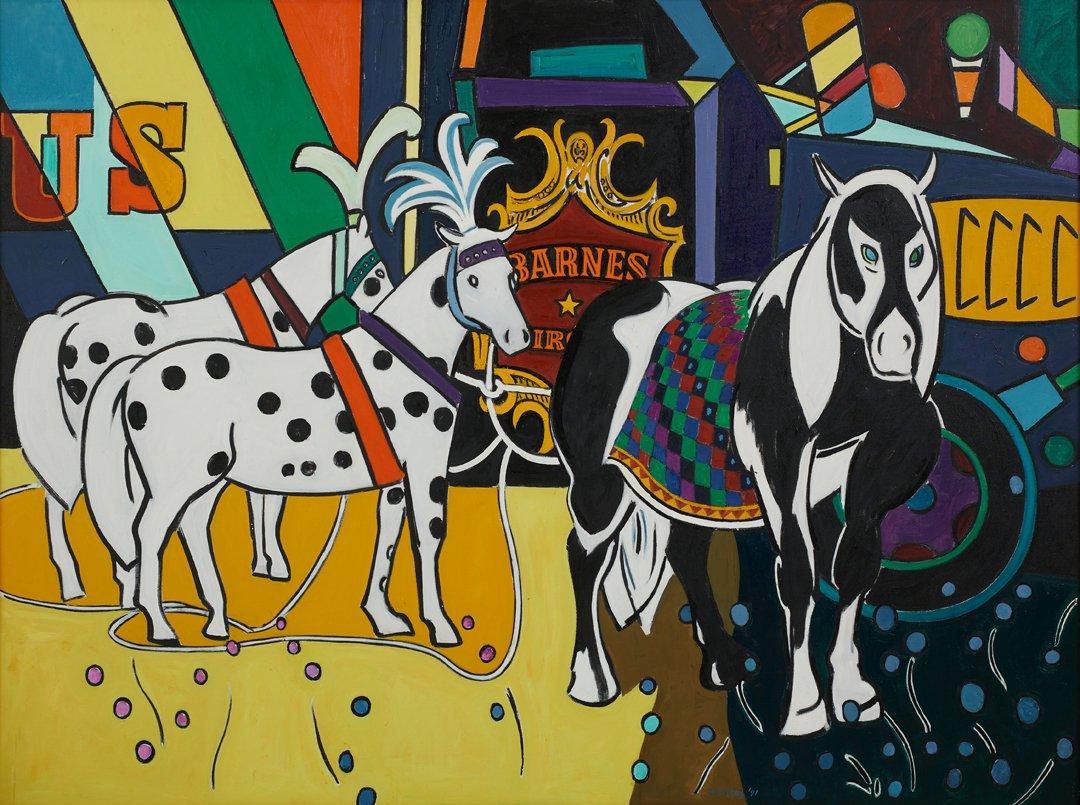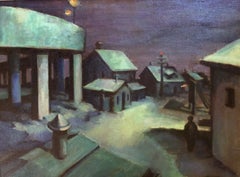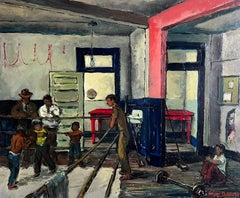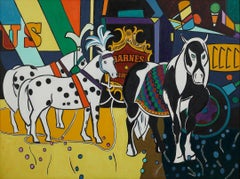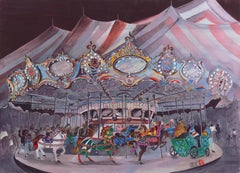Items Similar to Circus Wagons
Want more images or videos?
Request additional images or videos from the seller
1 of 6
Millard SheetsCircus Wagons1927
1927
$5,000
£3,712.23
€4,325.77
CA$6,941.62
A$7,764.63
CHF 4,040.76
MX$95,585.28
NOK 51,406.85
SEK 48,229.76
DKK 32,274.59
Shipping
Retrieving quote...The 1stDibs Promise:
Authenticity Guarantee,
Money-Back Guarantee,
24-Hour Cancellation
About the Item
This watercolor is part of our exhibition America Coast to Coast: Artists of the 1930s
Circus Wagons, 1927, watercolor on paper, signed and dated lower left, 10 x19 ¾ inches (sight), provenance includes Stary-Sheets Art Gallery (Gualala, CA); J. Ralph & Louis Stone Foundation; presented in a newer metal frame behind glazing
About the Painting
Millard Sheets was only twenty years old and in his third year of studies at the Chouinard Art Institute when he painted Circus Wagons. Despite his youth, Sheets was already an accomplished artist who had publicly exhibited his work and won prestigious prizes. Within several years, he would have his first solo exhibition at one of Los Angeles’ premiere galleries and become a painting instructor at his alma mater. In Circus Wagons we already see Sheets deft handling of the watercolor medium and his interest in the California Scene. In this case, Sheets captures a back lot view of a traveling circus, a subject he sometimes returned to, including in a color screen print in the collection of the National Gallery. Sheets made a career by painting what he knew and observed firsthand. This approach allowed Sheets to capture with authenticity the details of each narrative. Even with a narrowly limited palette and an economy of brushstrokes, Sheets effectively depicts the southern California scene with its strong and mysterious shadows, as well as the workers and circus animals. Seen through the hindsight of his six-decade long career, Circus Wagons offers a fascinating insight into the early development of California Scene painting which would by the mid-1930s become the best recognized style on the West Coast.
About the Artist
Millard Sheets was the dean of California watercolorists. His list of accomplishments is so extensive that his entry in Who was Who in American Art is over forty lines. Born in Pomona, California, Sheets became a painter at an early age, winning a prize at the Los Angeles County Fair in 1918. By the mid to late-1920s, Sheets became a regular at art exhibitions in the western part of the United States, winning several additional prizes before he reached the age of twenty-five. Sheets studied at the prestigious Chouinard Art Institute from 1925 through 1929 with Frank Tolles Chamberlin and Clarence Hinkle and had his first solo show with Los Angeles’ Dalzell Hatfield Gallery in 1929. During the 1930s, Sheets was invited to exhibit at almost every major American Museum and in many ways, his work came to represent the California watercolor school. This success allowed Sheets to devote much of his time to working as a professional artist. His contemporary and friend, Edward Biberman, recalled that Millard Sheets may have been the only Southern California artist during the Depression Era to support himself primarily through the sale of his paintings. In addition to these sales, Sheets was an art instructor at Chouinard, the Otis Art Institute and Scripps College, where he eventually became the head of the Art Department. During World War II, Sheets served as an artist for Life magazine. Later, he was on the Board of Trustees for the California Institute of Arts and Scripps College. In addition to his paintings, Sheets was an architectural designer who produced over one hundred murals and mosaics, many of which were installed at Home Savings & Loan buildings throughout California. His works are in the permanent collection of dozens of public collections, including the Museum of Modern Art, the Metropolitan Museum of Art, the Los Angeles County Museum of Art, and the Art Institute of Chicago.
- Creator:Millard Sheets (1907 - 1989, American)
- Creation Year:1927
- Dimensions:Height: 10 in (25.4 cm)Width: 19.75 in (50.17 cm)Depth: 2 in (5.08 cm)
- More Editions & Sizes:10 x 19.75Price: $5,000
- Medium:
- Movement & Style:
- Period:
- Condition:
- Gallery Location:Los Angeles, CA
- Reference Number:1stDibs: LU1859213056982
About the Seller
5.0
Vetted Professional Seller
Every seller passes strict standards for authenticity and reliability
1stDibs seller since 2022
15 sales on 1stDibs
Typical response time: 19 hours
- ShippingRetrieving quote...Shipping from: Los Angeles, CA
- Return Policy
Authenticity Guarantee
In the unlikely event there’s an issue with an item’s authenticity, contact us within 1 year for a full refund. DetailsMoney-Back Guarantee
If your item is not as described, is damaged in transit, or does not arrive, contact us within 7 days for a full refund. Details24-Hour Cancellation
You have a 24-hour grace period in which to reconsider your purchase, with no questions asked.Vetted Professional Sellers
Our world-class sellers must adhere to strict standards for service and quality, maintaining the integrity of our listings.Price-Match Guarantee
If you find that a seller listed the same item for a lower price elsewhere, we’ll match it.Trusted Global Delivery
Our best-in-class carrier network provides specialized shipping options worldwide, including custom delivery.More From This Seller
View AllMoonlight Shanties
Located in Los Angeles, CA
Moonlight Shanties, c. 1940s, oil on canvas, 24 x 18 inches, signed lower right, signed and titled verso
About the Painting
In Moonlight Shanties, Joachim depicts a lower-class neighborhood sitting along-side an elevated road or railway which crowds out the small nearby houses and structures. Joachim’s use of an expressionist palette and gestural brushstrokes together with the isolated figures obscured in the shadows, create a feeling of unease, isolation and even loneliness. From the 1920s through 1940s, American artists commonly employed expressionist conventions in their social realist works which portrayed the gritty side of urban America, especially the communities of the city-dwelling poor. Expressionist styles were considered appropriate for bridging the gap between the modernist idea of art-for-art’s-sake and the narrative qualities demanded by the dual crises of the Great Depression and World War II. Moonlight Shanties successfully uses these expressionist methods to portray a neighborhood and its people who appear to be literally and figuratively “on the edge.”
About the Artist
Paul Lamar Joachim...
Category
1940s American Modern Landscape Paintings
Materials
Oil
Mickey Finn Youth Club
Located in Los Angeles, CA
Mickey Finn Youth Club, 1951, oil on Masonite, signed and dated lower right, signed, titled and dated verso, 20 x 24 inches, presented in an older frame
Edgar Kiechle was a Los Ange...
Category
1950s American Realist Interior Paintings
Materials
Canvas, Oil
What a Life
Located in Los Angeles, CA
What a Life, c. 1930, mixed media on board, 18 x 24 inches, signed lower left; titled on label; exhibited at The San Francisco Art Association Fifty-Second Annual Exhibition at the P...
Category
1920s American Modern Figurative Paintings
Materials
Mixed Media
The Show is On
Located in Los Angeles, CA
The Show is On, 1940, oil on canvas, signed and dated lower right, 24 x 20 inches, exhibited: 30th Annual Exhibition of the Associated Artists of Pittsburgh, Carnegie Institute, Pitt...
Category
1940s American Modern Figurative Paintings
Materials
Canvas, Oil
Knight’s Lodging
Located in Los Angeles, CA
This painting is part of our exhibition American Coast to Coast: Artists of the 1930s
Knight’s Lodging, 1941, oil on canvas panel, signed and dated lower left, 16 x 20 inches, exhi...
Category
1940s American Realist Figurative Paintings
Materials
Oil
Bowling
Located in Los Angeles, CA
(Note: This work is part of our exhibition Connected by Creativity: WPA Era Works from the Collection of Leata and Edward Beatty Rowan)
Watercolor on paper, 7 ¾ x 10 ½ inches unframed, 14 ½ x 16 ½ inches framed, signed, dated, and located lower left as follows: “David McCosh...
Category
1920s American Modern Figurative Drawings and Watercolors
Materials
Watercolor
You May Also Like
Horses Prepared to Perform and Circus Truck, Contemporary American Modern
By Joseph O'Sickey
Located in Beachwood, OH
Work sold to benefit the CLEVELAND INSTITUTE OF ART
Joseph B. O’Sickey (American, 1918–2013)
Horses Prepared to Perform and Circus Truck, Circus Series, 1991
Oil on canvas
Signed an...
Category
1990s Post-Impressionist Animal Paintings
Materials
Oil
'The Race for the Brass Ring', Carousel, Merry-Go-Round, Amusement Ride, Funfair
Located in Santa Cruz, CA
Signed lower right, 'A. Dygert' for Audrey Dygert (American, 1922-2010) with artist seal and painted circa 1985.
Born Audrey Harper of Albany, California, Audrey Dygert was a lifel...
Category
1980s Other Art Style Animal Drawings and Watercolors
Materials
Watercolor, Gouache, Illustration Board
Circus Lot at Toledo, Ohio, Early 20th Century Cleveland School Artist
By Frank Wilcox
Located in Beachwood, OH
Frank Nelson Wilcox (American, 1887-1964)
Circus Lot at Toledo, c. 1920
Watercolor on Whatman board
Signed lower right
22 x 30 inches
Frank Nelson Wilcox (October 3, 1887 – April 17, 1964) was a modernist American artist and a master of watercolor. Wilcox is described as the "Dean of Cleveland School painters," though some sources give this appellation to Henry Keller or Frederick Gottwald. Wilcox was born on October 3, 1887 to Frank Nelson Wilcox, Sr. and Jessie Fremont Snow Wilcox at 61 Linwood Street in Cleveland, Ohio. His father, a prominent lawyer, died at home in 1904 shortly before Wilcox' 17th birthday. His brother, lawyer and publisher Owen N. Wilcox, was president of the Gates Legal Publishing Company or The Gates Press. His sister Ruth Wilcox was a respected librarian.
In 1906 Wilcox enrolled from the Cleveland School of Art under the tutelage of Henry Keller, Louis Rorimer, and Frederick Gottwald. He also attended Keller's Berlin Heights summer school from 1909. After graduating in 1910, Wilcox traveled and studied in Europe, sometimes dropping by Académie Colarossi in the evening to sketch the model or the other students at their easels, where he was influenced by French impressionism. Wilcox was influenced by Keller's innovative watercolor techniques, and from 1910 to 1916 they experimented together with impressionism and post-impressionism. Wilcox soon developed his own signature style in the American Scene or Regionalist tradition of the early 20th century. He joined the Cleveland School of Art faculty in 1913. Among his students were Lawrence Edwin Blazey, Carl Gaertner, Paul Travis, and Charles E. Burchfield. Around this time Wilcox became associated with Cowan Pottery.
In 1916 Wilcox married fellow artist Florence Bard, and they spent most of their honeymoon painting in Berlin Heights with Keller. They had one daughter, Mary. In 1918 he joined the Cleveland Society of Artists, a conservative counter to the Bohemian Kokoon Arts Club, and would later serve as its president. He also began teaching night school at the John Huntington Polytechnic Institute at this time, and taught briefly at Baldwin-Wallace College.
Wilcox wrote and illustrated Ohio Indian Trails in 1933, which was favorably reviewed by the New York Times in 1934. This book was edited and reprinted in 1970 by William A. McGill. McGill also edited and reprinted Wilcox' Canals of the Old Northwest in 1969. Wilcox also wrote, illustrated, and published Weather Wisdom in 1949, a limited edition (50 copies) of twenty-four serigraphs (silk screen prints) accompanied by commentary "based upon familiar weather observations commonly made by people living in the country."
Wilcox displayed over 250 works at Cleveland's annual May Show. He received numerous awards, including the Penton Medal for as The Omnibus, Paris (1920), Fish Tug on Lake Erie (1921), Blacksmith Shop (1922), and The Gravel Pit (1922). Other paintings include The Trailing Fog (1929), Under the Big Top (1930), and Ohio Landscape...
Category
1920s American Modern Figurative Drawings and Watercolors
Materials
Watercolor
In the circus town
Located in Zofingen, AG
In this oil painting, I sought to capture a vibrant, bustling scene from a circus town. The warm sunlight bathes the characters—depict lovers of performing arts, and the splendid hor...
Category
20th Century Impressionist Figurative Paintings
Materials
Oil
“Big Tent” An American Traveling Circus Comes to Town
By Clifford Holmes
Located in San Francisco, CA
Before there was the Cirque du Soleil to astonish audiences with extraordinary acrobatics and spectacular showmanship, America’s traveling circuses drew patrons to enormous tents pit...
Category
Mid-20th Century American Modern Landscape Paintings
Materials
Masonite, Oil
Circus
Located in Genève, GE
Work on canvas
Golden wooden frame
109 x 109 x 6 cm
Category
Late 20th Century Italian School Figurative Paintings
Materials
Oil
$2,838
